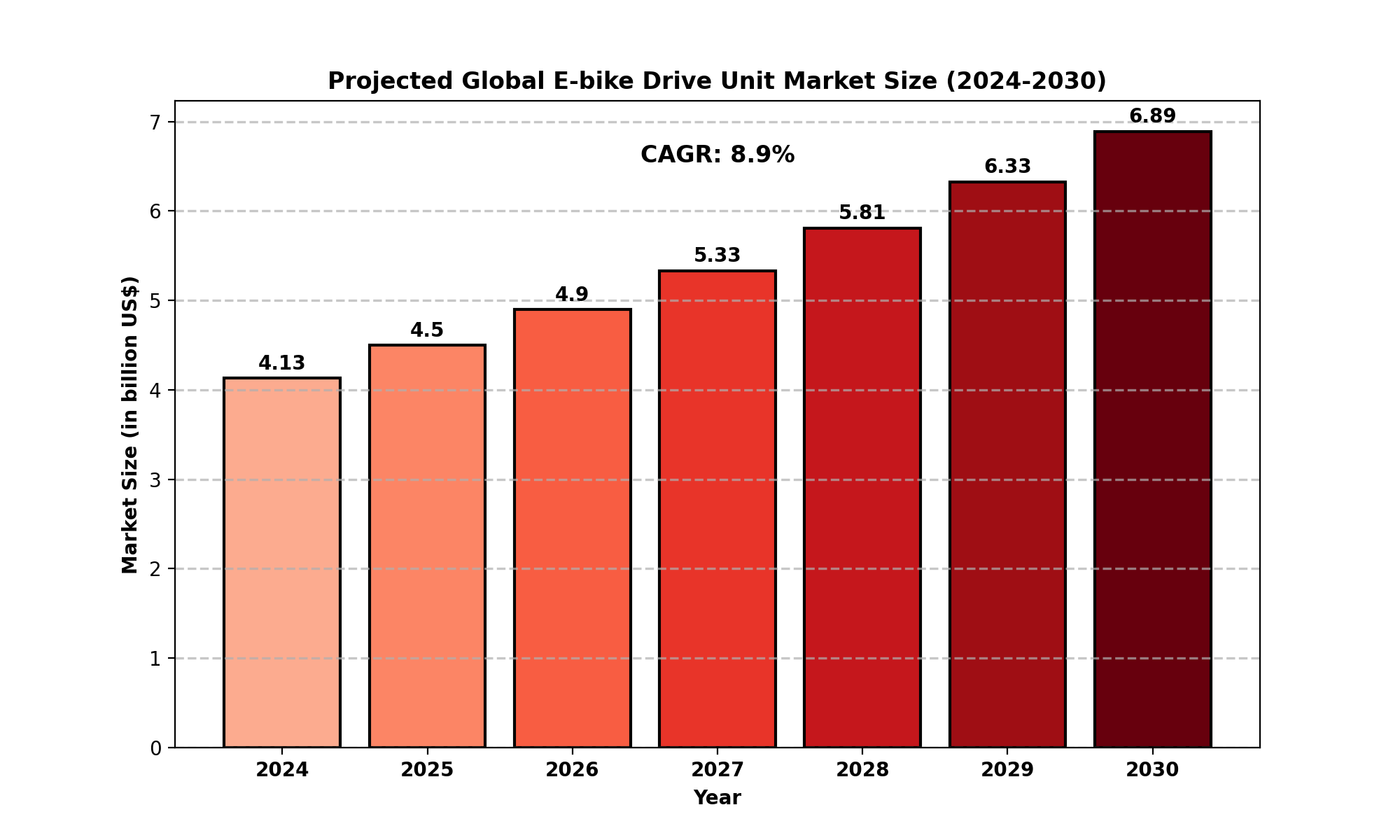TOP CATEGORY: Chemicals & Materials | Life Sciences | Banking & Finance | ICT Media

Download Report PDF Instantly
Report overview
The E-bike Drive Unit is the core component of an electric bicycle, responsible for providing power assistance to the rider. It includes essential elements such as the motor, controller, and battery management system (BMS). These components work in unison to enhance performance, efficiency, and ride experience. E-bike drive units come in various types, primarily categorized into mid-drive motors and hub motors, each offering distinct advantages in terms of torque, efficiency, and riding experience.
The global E-bike Drive Unit market was valued at US$ 4.13 billion in 2024 and is projected to reach US$ 6.89 billion by 2030, growing at a CAGR of 8.9% during the forecast period (2024-2030).
The United States E-bike Drive Unit market was valued at US$ 852.7 million in 2024 and is expected to grow to US$ 1.37 billion by 2030, registering a CAGR of 8.2% during the same period.
The increasing adoption of e-bikes for urban mobility, environmental consciousness, and government incentives for electric vehicles are major growth drivers.

Drivers
Increasing Adoption of E-bikes: Urban commuters are shifting to e-bikes due to traffic congestion, cost savings, and environmental benefits.
Government Incentives and Regulations: Various governments offer subsidies and tax benefits to encourage e-bike adoption.
Advancements in Battery and Motor Technologies: The development of lightweight, efficient motors with improved range is accelerating market growth.
Health and Fitness Trends: Consumers are opting for e-bikes for exercise and recreation, boosting demand.
Restraints
Battery Technology Limitations: Limited range and longer charging times hinder adoption.
High Initial Cost: E-bikes and their drive units remain costlier compared to traditional bicycles.
Regulatory Variations Across Regions: Different countries have diverse e-bike laws, affecting market penetration.
Opportunities
Integration of Smart Features: Connectivity, GPS tracking, and IoT-based monitoring create new growth avenues.
Expansion in Emerging Markets: Growing demand in Asia-Pacific, Latin America, and the Middle East provides lucrative opportunities.
Sustainable and Green Mobility Trends: The push for eco-friendly transport solutions supports market expansion.
Challenges
Supply Chain Disruptions: Material shortages and production delays impact manufacturing.
Competition from Alternative Micromobility Solutions: E-scooters and shared mobility services pose a threat.
North America
The U.S. and Canada lead in e-bike adoption due to strong consumer demand and supportive policies.
Rising fuel costs and urban congestion drive market expansion.
Europe
Countries like Germany, the Netherlands, and France dominate due to advanced cycling infrastructure.
Stringent emissions regulations encourage e-bike usage.
Asia-Pacific
China, Japan, and India are major markets, benefiting from large-scale production and rising urbanization.
Government subsidies in China significantly boost adoption.
South America
Growing urbanization and increasing disposable income contribute to market growth.
Brazil and Argentina lead the regional market.
Middle East & Africa
Increasing focus on sustainable transport solutions in UAE and South Africa supports market expansion.
Key Companies
Bosch: A global leader offering advanced e-bike drive units.
Continental: Known for innovative, high-performance motors.
Yamaha Motor: Strong presence in mid-drive motor technology.
Panasonic: Focuses on energy-efficient drive systems.
Shimano: A leading supplier of e-bike drive components.
OEMs (Original Equipment Manufacturers): Dominates the market as manufacturers integrate drive units into their e-bike models.
Aftermarket: Growing demand for upgradable and replacement drive units supports this segment.
Mid-Drive Motors: Preferred for efficiency and better weight distribution.
Hub Motors: Cost-effective and easier to install.
North America: USA, Canada, Mexico
Europe: Germany, UK, France, Russia, Italy, Rest of Europe
Asia-Pacific: China, Japan, South Korea, India, Southeast Asia, Rest of Asia-Pacific
South America: Brazil, Argentina, Colombia, Rest of South America
Middle East & Africa: Saudi Arabia, UAE, Egypt, Nigeria, South Africa, Rest of MEA
What is the current market size of the E-bike Drive Unit market?
Which are the key companies operating in the E-bike Drive Unit market?
What are the key growth drivers in the E-bike Drive Unit market?
Which regions dominate the E-bike Drive Unit market?
What are the emerging trends in the E-bike Drive Unit market?
Industry drivers, restraints, and opportunities covered in the study
Neutral perspective on the market performance
Recent industry trends and developments
Competitive landscape & strategies of key players
Potential & niche segments and regions exhibiting promising growth covered
Historical, current, and projected market size, in terms of value
In-depth analysis of the E-bike Drive Unit Market
Overview of the regional outlook of the E-bike Drive Unit Market:
Access to date statistics compiled by our researchers. These provide you with historical and forecast data, which is analyzed to tell you why your market is set to change
This enables you to anticipate market changes to remain ahead of your competitors
You will be able to copy data from the Excel spreadsheet straight into your marketing plans, business presentations, or other strategic documents
The concise analysis, clear graph, and table format will enable you to pinpoint the information you require quickly
Provision of market value (USD Billion) data for each segment and sub-segment
Indicates the region and segment that is expected to witness the fastest growth as well as to dominate the market
Analysis by geography highlighting the consumption of the product/service in the region as well as indicating the factors that are affecting the market within each region
Competitive landscape which incorporates the market ranking of the major players, along with new service/product launches, partnerships, business expansions, and acquisitions in the past five years of companies profiled
Extensive company profiles comprising of company overview, company insights, product benchmarking, and SWOT analysis for the major market players
The current as well as the future market outlook of the industry concerning recent developments which involve growth opportunities and drivers as well as challenges and restraints of both emerging as well as developed regions
Includes in-depth analysis of the market from various perspectives through Porter’s five forces analysis
Provides insight into the market through Value Chain
Market dynamics scenario, along with growth opportunities of the market in the years to come
6-month post-sales analyst support
In case of any queries or customization requirements, please connect with our sales team, who will ensure that your requirements are met.
Chapter Outline
Chapter 1 mainly introduces the statistical scope of the report, market division standards, and market research methods.
Chapter 2 is an executive summary of different market segments (by region, product type, application, etc), including the market size of each market segment, future development potential, and so on. It offers a high-level view of the current state of the E-bike Drive Unit Market and its likely evolution in the short to mid-term, and long term.
Chapter 3 makes a detailed analysis of the market's competitive landscape of the market and provides the market share, capacity, output, price, latest development plan, merger, and acquisition information of the main manufacturers in the market.
Chapter 4 is the analysis of the whole market industrial chain, including the upstream and downstream of the industry, as well as Porter's five forces analysis.
Chapter 5 introduces the latest developments of the market, the driving factors and restrictive factors of the market, the challenges and risks faced by manufacturers in the industry, and the analysis of relevant policies in the industry.
Chapter 6 provides the analysis of various market segments according to product types, covering the market size and development potential of each market segment, to help readers find the blue ocean market in different market segments.
Chapter 7 provides the analysis of various market segments according to application, covering the market size and development potential of each market segment, to help readers find the blue ocean market in different downstream markets.
Chapter 8 provides a quantitative analysis of the market size and development potential of each region and its main countries and introduces the market development, future development prospects, market space, and capacity of each country in the world.
Chapter 9 introduces the basic situation of the main companies in the market in detail, including product sales revenue, sales volume, price, gross profit margin, market share, product introduction, recent development, etc.
Chapter 10 provides a quantitative analysis of the market size and development potential of each region in the next five years.
Chapter 11 provides a quantitative analysis of the market size and development potential of each market segment (product type and application) in the next five years.
Chapter 12 is the main points and conclusions of the report.